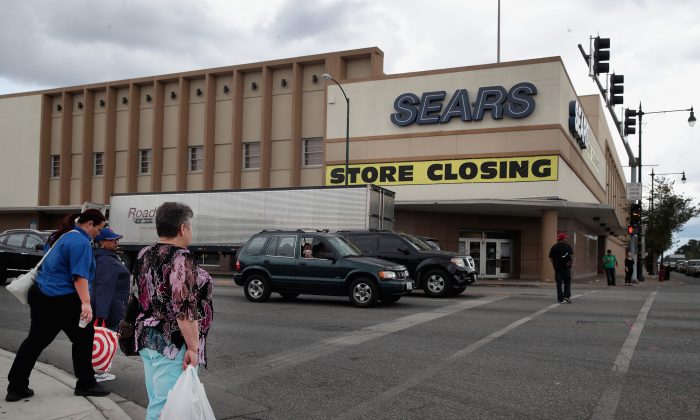A year ago, a Sears bankruptcy would have fit better into the U.S. retail narrative, given the steady decline of shopping malls and foundering chains. Today, however, with shoppers feeling more free to spend and nicer malls on the upswing, bankruptcy is a clear sign of individual weakness, not an industry trend.
Sears Holdings Corp., once a force in U.S. retail so dominant that it could be called the Amazon of the 20th century, has been suffocated by debt and a steady erosion of revenue. While department-store competitors invested in e-commerce and tried new brands and formats, Sears withered as majority shareholder and Chief Executive Officer Eddie Lampert repeatedly cut costs and shuttered stores.
“The retailers that are succeeding are investing in being good retailers,” said Ivan Feinseth, chief investment officer of Tigress Financial Partners. “All Sears did was close stores and sell assets, and it was a study in financial engineering that didn’t work.”
In other words, don’t expect the Sears failure to be a contagion threatening to infect the rest of retail.
Debt Crippled
The company filed for Chapter 11 protection from creditors early on Oct. 15, listing more than $10 billion in debts and more than $1 billion in assets. Sears and its Kmart stores plan to stay in business for now, with help from $600 million in new loans.
Like Sears, Toys “R” Us Inc. was crippled by debt, which caused it to liquidate operations despite last year’s $11.5 billion of revenue. Both companies had seen cash flow increasingly constrained by interest payments. Sears has the added pressure of pension liabilities.
Meanwhile, the rise of Amazon.com Inc. has forced retailers into an expensive race to provide the online and delivery capabilities that consumers demand. Shoppers also are expecting customer service that goes beyond ringing up a cash register.
Walmart Inc. and Target Corp. have led the charge, expanding delivery and options like curbside pickup. Both have much lower debt levels and are tolerating the narrowing margins as a necessary cost of business.
Other retailers have experienced varying degrees of success. But with the U.S. economy strong and unemployment low, most chains’ prospects are brighter today than they were a year ago. Investors have seized on the companies that are poised to survive the industry’s protracted shakeup.
Sears, ironically perhaps, just held a showcase for a renovated store in the Chicago suburb of Oak Brook, Illinois. On a recent afternoon, the store was clean and bright, with a welcome center offering hot drinks and plush chairs. A few customers browsed the aisles, stocked neatly with Isotoner gloves and Rosetti handbags at a 40 percent discount.
Gloomy Weather
Cashier Christian Ambrosio, 22, blamed gloomy weather for the lack of customers. The parking lot, still under construction, held about 10 cars.
Ambrosio said he attended the Oct. 4 re-opening, which brought out actress and Sears clothing designer Jaclyn Smith. He said the store has been pretty quiet since then.
“The younger customers, they’re inside the malls like at the food courts” and shopping at H&M and Express, he said.
Sears shares have lost about 90 percent of their value this year.
Smaller apparel chains like American Eagle Outfitters Inc. and Urban Outfitters Inc. have rebounded in recent quarters as shoppers have started spending again. Meanwhile, bigger stores like Best Buy Inc. have steadily siphoned off some of the appliance sales that traditionally went to Sears.
It’s unclear whether the Oak Brook blueprint will be enough to bring in shoppers who might have defected long ago or who feel no loyalty to the brand.
“Too much rot has set in at Sears to make it viable business,” Neil Saunders, managing director of GlobalData Retail, said in an email. “The brand is now tarnished just as the economics of its model are firmly stacked against its future success.”
While the company will remain open through the holiday period, its bankruptcy might deter some shoppers from buying big-ticket items there because of concern that Sears won’t be around much longer to back guarantees or take returns, Saunders said.
Best Locations
Sears has also struggled because it’s sold off some of its best locations. Oak Brook is an affluent suburb, but the timing of the renovation could be better. The store reopened just months after McDonald’s moved its corporate headquarters from across the highway to downtown Chicago.
David Tawil, co-founder and president of Maglan Capital, said Sears is more of a “unique, one-off situation,” rather than a reflection of retail’s broader plight. He cited Sears’s unusual relationship with Lampert, who for years fended off the retailers’ demise by paying off debt and selling assets. Lampert is also the largest shareholder in businesses that have been spun off, such as Seritage Growth Properties, a real estate investment trust that counts Sears as its biggest tenant, and Sears Hometown and Outlet Stores Inc.
Sears has closed hundreds of stores in recent years in a bid to cut expenses. Other businesses that were sold or spun off include Craftsman tools and apparel company Lands’ End Inc.
“Closing stores and selling good assets only leaves you with no stores left to close and no good assets,” said Feinseth of Tigress. “It’s the ultimate pulling the plants and watering the weeds.”
Hoffman Estates, Illinois-based Sears has tens of thousands of employees uncertain about their future and, despite corporate travails, loyal customers.
At a Brooklyn, New York, store, Glenda Mitchell, 53, and her mother were recently in the process of buying toys for the grandkids along with a smattering of other shoppers. Mitchell said she’s been coming to Sears for more than 20 years and will miss it if it goes away.
“This is basically the only store my mom usually comes to shop at,” Mitchell said. “Look at the foot traffic. Where are these people going when Sears closes?”
By Leslie Patton, Hema Parmar & Gerald Porter Jr.
From The Epoch Times

